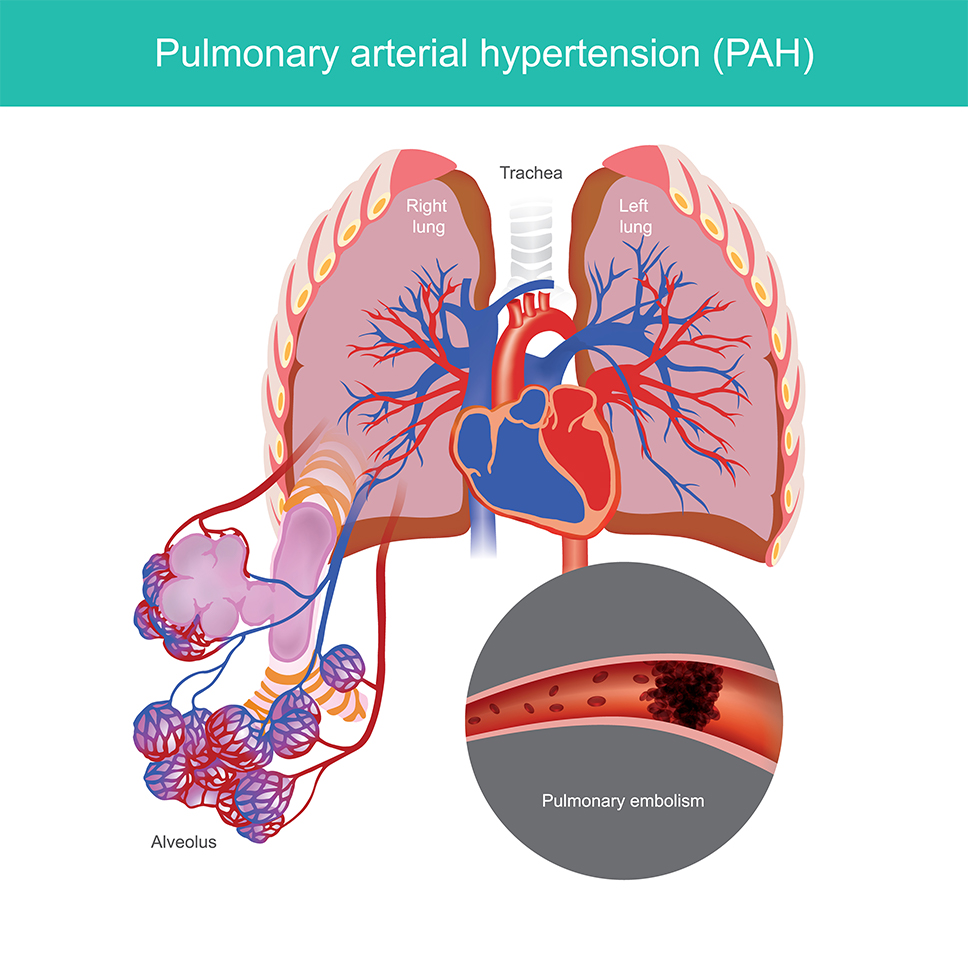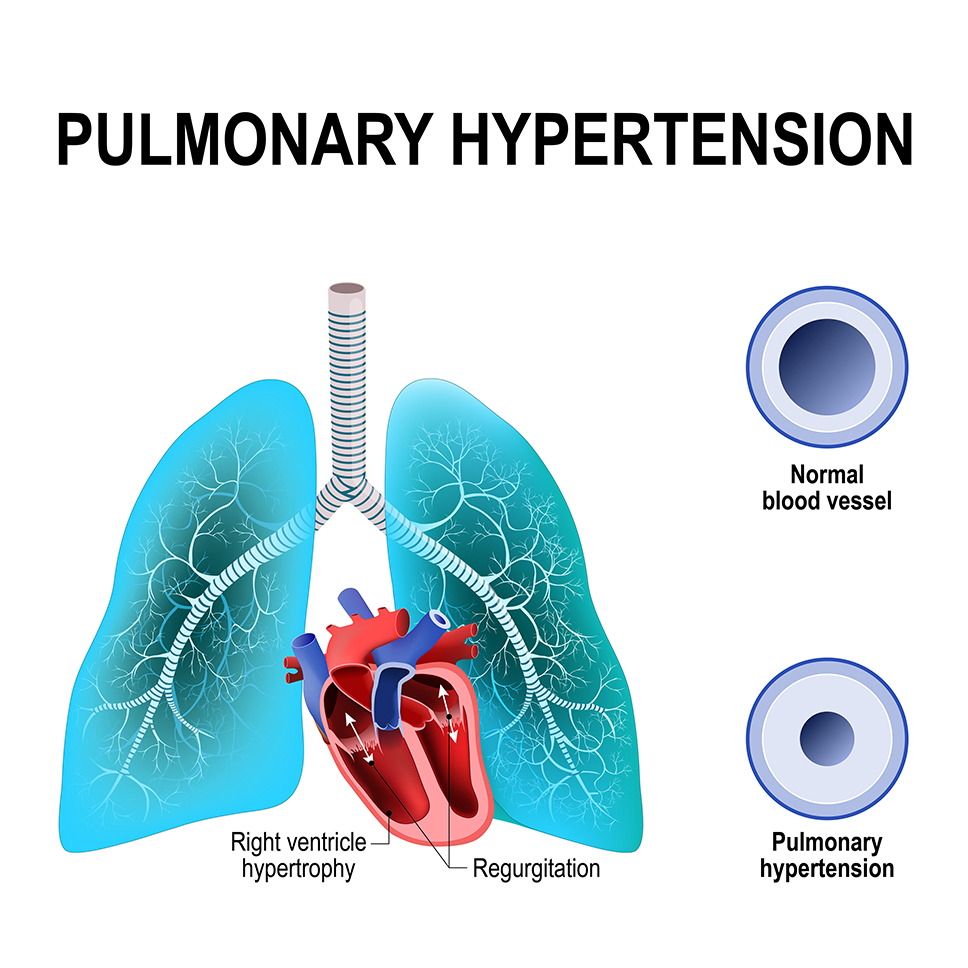Pulmonary Artery Hypertension
What is pulmonary artery hypertension?
- High blood pressure in the arteries of the lungs(pulmonary arteries), is known as Pulmonary artery hypertension
- This condition occurs when the blood pressure in pulmonary arteries is increased; the heart has to overcome a higher load to pump the blood that results in heart failure.
- Overtime can damage the heart muscle, specifically the right side of the heart.
- This is a serious and life-threatening condition.
- Pulmonary artery hypertension is caused due to problem within pulmonary arteries or could be consequent to different medical conditions include:
- Group 1: Idiopathic pulmonary hypertension
- Group 2: Due to a heart problem
- Group 3: Due to lung problem
- Group 4: Due to blood clots in the lungs(pulmonary emboli)
- Group 5: Due to other medical problems

What are the symptoms of pulmonary artery hypertension?
- Shortness of breath
- Fatigue
- Dizziness
- Chest discomfort or pain
- Abnormal heartbeat
- Ascites (Abnormal fluid buildup in the abdomen)
- Swelling in legs and ankles
- Bluish discolouration of skin and lips
What are the risk factors for developing pulmonary artery hypertension?
- Obesity
- Blood clotting disorders
- Family history of pulmonary artery disease
- Congenital heart disease
- Living in high altitude
- Exposure to asbestos
- Certain medications like cocaine, selective serotonin reuptake inhibitors
What are the complications of pulmonary artery hypertension?
- Heart failure
- Atrial fibrillation
- Sudden death

How is pulmonary artery hypertension diagnosed?
- Electrocardiogram
- Echocardiogram
- Chest X-ray
- CT scan of lungs and pulmonary arteries
- Cardiac catheterization: A thin tube/catheter is passed into the pulmonary aorta to check blood pressure in the pulmonary artery and right side of the heart
- Lung biopsy: Small sample of lung tissue is collected to determine the cause of pulmonary artery hypertension.
How is pulmonary artery hypertension treated?
Treatment of pulmonary artery hypertension depends upon the group in which pulmonary hypertension is due to:
Group 1: This type of pulmonary artery hypertension is caused by unknown factors and has got limited therapy in the form of medicines or Heart/lung transplantation.
Group 2: Treatment of the underlying cardiac condition can reverse pulmonary artery hypertension.
Group 3: Treatment of lung disorder will improve pulmonary artery hypertension.
Group 4: Treatment with medications and in severe cases surgical removal of blood clots in the blood vessel of lungs or by doing an angioplasty of thrombosed arteries improves the blood flow to lungs.
Group 5: Treatment of the underlying disease can reduce the blood pressure in pulmonary arteries and improve the blood flow to the lungs
What is the uniqueness of the treatment of pulmonary artery hypertension by Dr C Raghu?
Landmark clinical trials studying the efficacy of novel drugs are routinely conducted by Dr Raghu
Differentiating various groups of pulmonary hypertension by cardiac catheterization is routinely done
A dedicated physician assistant will be provided to closely monitor symptoms and complications.
Our Specialities
- Conditions
- Acute limb ischemia
- Chronic limb ischemia
- Aortic stenosis
- Mitral valve stenosis
- Mitral valve regurgitation
- Atrial fibrillation
- Tachycardia
- Bradycardia
- Palpitations
- High blood pressure
- Atrial septal defect
- Ventricular septal defect
- Patent ductus arteriosus
- Cardiac amyloidosis
- Hypertrophic cardiomyopathy
- Varicose veins
- Deep vein thrombosis (DVT)
- Myocarditis
- Endocarditis
- Pericarditis
- Peripheral arterial disease
- Pulmonary artery hypertension
- Pulmonary embolism
- Cath lab procedures:
- Coronary Angiogram
- Primary Angioplasty
- Coronary Angioplasty
- CHIP Angioplasty
- Aortic valve replacement surgery
- Mitral valve replacement surgery
- Device closure for Atrial septal defect
- Device closure for Ventricular septal defect
- Device closure for Patent Ductus Arteriosus
- Transcatheter aortic valve replacement (TAVR)
- Inferior vena cava (IVC) filter
- LA appendage closure
- Fistuloplasty
- Balloon mitral valvotomy
- 24 hours emergency services
- Clinics- weekly basis/monthly basis/ Yearly basis
- Prevention of cardiovascular diseases
- Diagnosis

